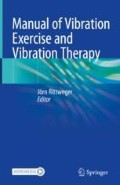Abstract
Vibrations are mechanical oscillations. They can be described by frequency, amplitude, phase and shape. There are several ways to describe amplitude, and these different terms cannot be used interchangeably. Moreover, each of these terms indicates different physical properties of the vibration signal, and thus has different relevance for benefits and risks by vibration exercise and therapy.
Vibrations can naturally emerge in systems that allow transfer between different types of energy, e.g., between potential and kinetic energy (pendulum) or between elastic and kinetic energy (spring-mass oscillator). Driven vibrations are generated by actuators that impose their own frequency onto another system. Resonance occurs when an actuator excites a natural oscillator at its preferred frequency, the so-called eigenfrequency.
Analysis of oscillatory signals has traditionally been performed with spectral analysis, which is based on Fourier’s harmonic analysis. More recently, wavelet analysis has been proposed for time-variant signals. A third opportunity is offered by averaging methods, such as peri-stimulus plots and peri-stimulus histograms, in particular when the shape of complex oscillations is of interest.
Access this chapter
Tax calculation will be finalised at checkout
Purchases are for personal use only
References
Tipler PA, Mosca G. Physics for scientists and engineers. New York: W.H. Freeman and Company; 2008.
Nigg BM, Herzog W, editors. Biomechanics of the musculo-skeletal system. 3rd ed. Chichester: Wiley; 2007.
Özkaya N, Nordin M. Fundamentals of biomechanics. New York: Springer; 1998.
Rauch F, Sievanen H, Boonen S, Cardinale M, Degens H, Felsenberg D, et al. Reporting whole-body vibration intervention studies: recommendations of the International Society of Musculoskeletal and Neuronal Interactions. J Musculoskelet Neuronal Interact. 2010;10(3):193–8.
Oppenheim AV, Lim JS. The importance of phase in signals. Proceed IEEE. 1981;69:529.
Rittweger J. Vibration as an exercise modality: how it may work, and what its potential might be. Eur J Appl Physiol. 2010;108(5):877–904.
Wakeling JM, Nigg BM, Rozitis AI. Muscle activity damps the soft tissue resonance that occurs in response to pulsed and continuous vibrations. J Appl Physiol. 2002;93(3):1093–103.
Kiiski J, Heinonen A, Jarvinen TL, Kannus P, Sievanen H. Transmission of vertical whole body vibration to the human body. J Bone Miner Res. 2008;23(8):1318–25.
Caryn RC, Dickey JP. Transmission of acceleration from a synchronous vibration exercise platform to the head during dynamic squats. Dose-Response. 2019;17(1):1559325819827467.
Shimazaki H, Shinomoto S. A method for selecting the bin size of a time histogram. Neural Comput. 2007;19(6):1503–27.
Cochrane DJ, Loram ID, Stannard SR, Rittweger J. Changes in joint angle, muscle-tendon complex length, muscle contractile tissue displacement, and modulation of EMG activity during acute whole-body vibration. Muscle Nerve. 2009;40(3):420–9.
Cardinale M, Rittweger J. Vibration exercise makes your muscles and bones stronger: fact or fiction? J Br Menopause Soc. 2006;12(1):12–8.
Author information
Authors and Affiliations
Corresponding author
Editor information
Editors and Affiliations
1 Electronic Supplementary Material
Excitation of a tuning fork, as an example of a natural oscillation (MOV 6608 kb)
Playground swing, as an example of a driven oscillation (MOV 12497 kb)
Rights and permissions
Copyright information
© 2020 Springer Nature Switzerland AG
About this chapter
Cite this chapter
Rittweger, J., Taiar, R. (2020). The Physics of Vibration. In: Rittweger, J. (eds) Manual of Vibration Exercise and Vibration Therapy. Springer, Cham. https://doi.org/10.1007/978-3-030-43985-9_1
Download citation
DOI: https://doi.org/10.1007/978-3-030-43985-9_1
Published:
Publisher Name: Springer, Cham
Print ISBN: 978-3-030-43984-2
Online ISBN: 978-3-030-43985-9
eBook Packages: MedicineMedicine (R0)

